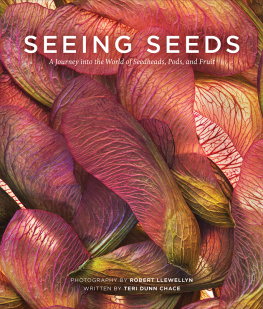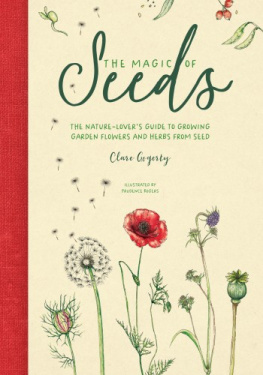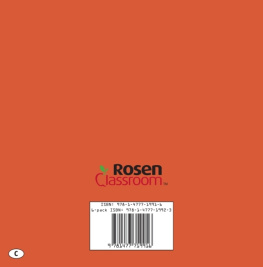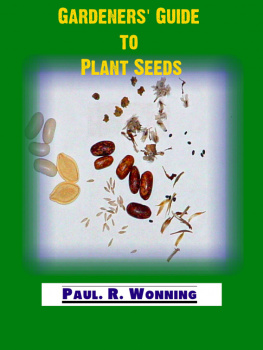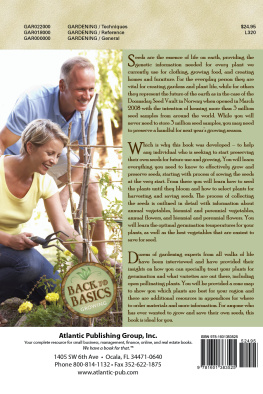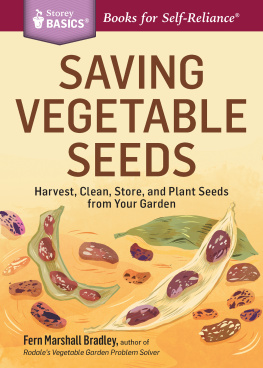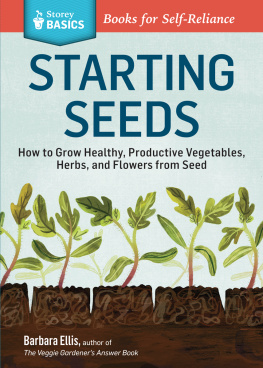

Seeing Seeds
A journey into the world of seedheads, pods, and fruit
Photography by
ROBERT LLEWELLYN
Written by
TERI DUNN CHACE
TIMBER PRESS
Portland, Oregon
Dedicated to SAVION GLOVER, who dances at the intersection of discipline and joy.
It occurs to me that seeds do the same thing, in their own way.
Page 1: A side view of a red maple key or samara. At this intimate level, it almost looks like part of a human or animal. Seeds in fact are alivealive but asleep.
Pages 23: The oddball fruit of the Kousa dogwood, which mature coral red and have pulpy, edible interiors.
Opposite: Salsify, a relative of the common dandelion, disperses its seeds on the wind.
Text copyright 2015 by Teri Dunn Chace.
Photographs copyright 2015 by Robert Llewellyn.
All rights reserved.
Published in 2015 by Timber Press, Inc.
An excerpt from the essay The Forest in the Seeds, in High Tide in Tucson, by Barbara Kingsolver (Harper Perennial, 1995), is reprinted by permission of the publisher.
An excerpt from the story The Author of the Acacia Seeds, in The Compass Rose, by Ursula K. LeGuin (HarperCollins, 1982), is reprinted by permission of Curtis Brown, Ltd.
An excerpt from the essay How Flowers Changed the World, in The Immense Journey, by Loren Eiseley (Vintage Books/Random House, 1959), is reprinted by permission of the publisher.
An excerpt from the chapter The Lives of a Cell, in The Lives of a Cell: Notes of a Biology Watcher, by Lewis Thomas (Bantam Books, 1979), is reprinted by permission of the publisher.
An excerpt from the chapter May, in The Rural Life, by Verlyn Klinkenborg (Little, Brown, and Company, 2003), is reprinted by permission of the publisher.
The information in this book is true and complete to the best of our knowledge. All recommendations are made without guarantee on the part of the author or Timber Press. The author and publisher disclaim any liability in connection with the use of this information. In particular, eating wild plants and their fruits and seeds is inherently risky. Plants can be easily mistaken and individuals vary in their physiological reactions to plants that are touched and consumed.
Timber Press
The Haseltine Building
133 S.W. Second Avenue, Suite 450
Portland, Oregon 97204-3527
timberpress.com
Text and cover design by Susan Applegate
Library of Congress Cataloging-in-Publication Data
Dunn Chace, Teri, author.
Seeing seeds: a journey into the world of seedheads, pods, and fruit/photography by Robert Llewellyn; written by Teri Dunn Chace.First edition.
pages cm
Includes bibliographical references and index.
ISBN 978-1-60469-492-5
1. Seeds. 2. SeedsPictorial works. I. Llewellyn, Robert J., illustrator. II. Title.
QK661.D866 2015
581.467dc23
2015006910
A catalog record for this book is also available from the British Library.
Though I do not believe that a plant will spring up where no seed has been, I have great faith in a seed. Convince me that you have a seed there, and I am prepared to expect wonders.
H ENRY D AVID T HOREAU
from the unfinished manuscript Faith in a Seed, 1862

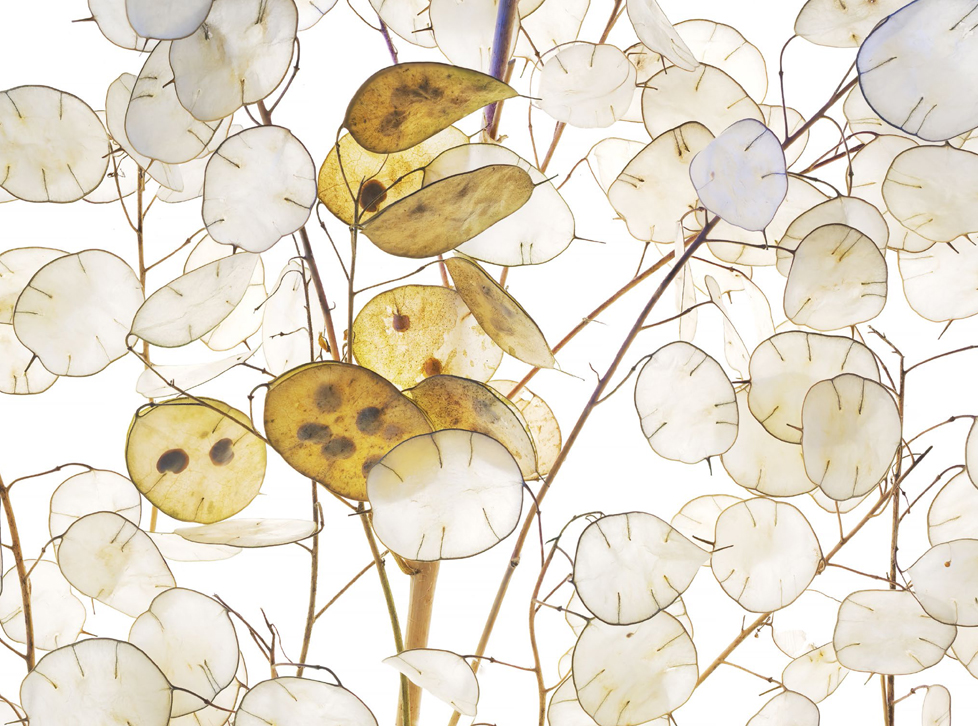
The strangely appealing pods of the money plant, Lunaria, are flat and thinsomewhat like coins. They can house a few flattened seeds, which are not released until the papery covering dries and disintegrates.
CONTENTS
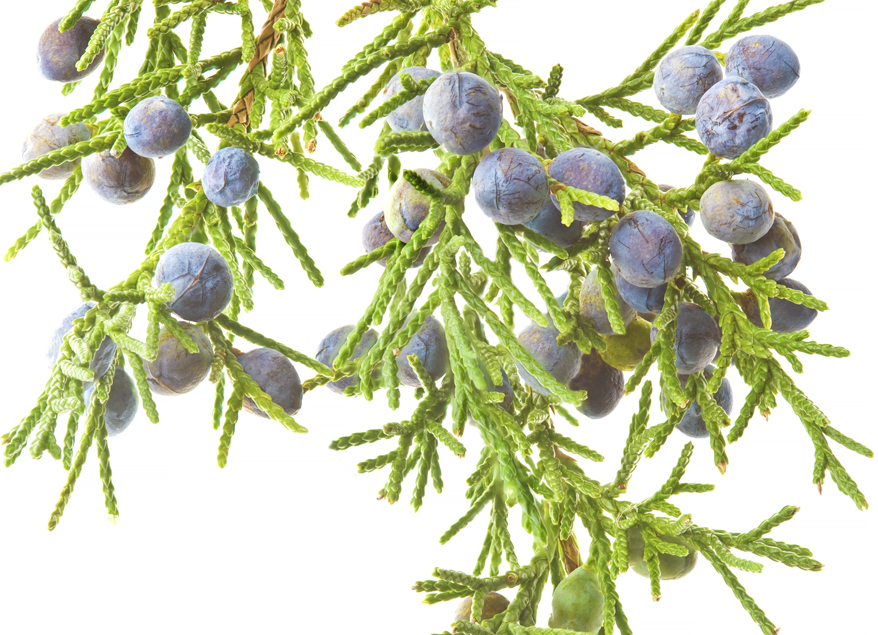
Eastern red cedar berries appear only on the female trees. Botanically they are small, seed-bearing cones.
INTRODUCTION
The edge of a mystery
If you have ever been on a journey and returned a changed person, I invite you to sit down with this book. Ive been on a seeds odyssey. Not with seeds in my pockets or sewn into my hemline like an immigrant, a preservationist, or a long-ago plant explorer, but with Bob Llewellyns exquisite and insightful photographs as my pathway. I had thought I was well equipped with horticultural and botanical knowledge, seeing as I am a lifelong gardener, an amateur botanist, and the author of various books about plants and nature. While I am not a scientist, I have delved into their thick books and scholarly papers. Although I am not a farmer, I have heeded reflections of everyone from Scott Chaskey to Vandana Shiva to Michael Abelman. I have also talked with local and distant farmers and gardening friends about this project.
Like a child in a fairy tale who follows a beckoning songbird far from home into unrecognizable territory, my seed journey began with curiosity and took me to strange places. Sometimes the load seemed heavy and the road looked longseeds are complicated and puzzling. Other times a seed revealed its inner secrets before drifting away on a breeze. The ingenuity of the seeds of this world, not to mention their sheer volume of production, is astounding and real. Many seeds are small, but we should underestimate none of them. What they contain and do is huge, mysterious, and important.
This book highlights 100 representative seeds, fruits, and pods. Even after settling on five logical categories, I questioned some of the designated slots. Seed versatility is a given, and variations in form and function are legion. But we can discern patterns and principles. These pages are but a glimpse into the complexities and quirks of plant life and its drive to reproduce and ensure its own continuation.
Some seeds appear to follow a straightforward path. A flower is pollinated, petals fall off, and the ovary swells with ripening seeds. But even this sequence is a remarkable achievement when we examine the discernible steps. Other plants do things their own way. Horsetail spores literally dance into new growing locations. Cedar cones hoard winged seeds insideuntil they dont. Wisteria pods, touch-me-nots, and okra catapult ripe seeds. Most figs are parthenocarpic, and thus bypass sexual reproduction. Datura seeds poison you or take you out of your mind. Even teeny-tiny rose seeds are not simple structures; extracting them from rose hips and sowing them will not produce a plant like the parent. I hope that after you spend some time with Bobs images and my short expositions, you will begin to notice and respect any seeds you encounter, anywhere.
In the end, like the adventurers who took Jules Vernes imaginary journey to the center of the earth, travelers in the realm of seeds witness things both familiar and bizarre, test various assumptions, and emerge in a new place. That different location is still on this planet, but the future is fragile and understanding is provisional. It is within our power to learn more about and participate in the diverse circle of life. Everything plants do or can do, every fruit or pod or loose seed, is connected to us and to all living things. There is no autonomy; nothing is entirely solitary. To say we are co-evolutionary with seeds is to graze the edge of a mystery. A life force is embedded in everything, not just in seeds.
Next page
